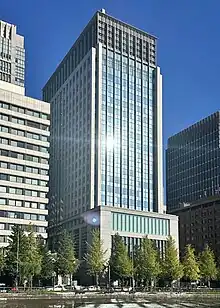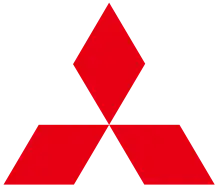Mitsubishi Corporation
Mitsubishi Corporation (三菱商事株式会社, Mitsubishi Shōji Kabushiki-gaisha) is Japan's largest trading company (sogo shosha) and a member of the Mitsubishi keiretsu. As of 2022, Mitsubishi Corporation employs over 80,000 people and has ten business segments, including energy, industrial finance, banking, machinery, chemicals, and food.[2]
 Headquarters in Marunouchi, Chiyoda, Tokyo | |
Native name | 三菱商事株式会社 |
|---|---|
Romanized name | Mitsubishi Shōji Kabushiki-gaisha |
| Formerly | Kowa Jitsugyo Kaisha Mitsubishi Shoji Kaisha, Ltd. |
| Type | Public KK |
| TYO: 8058 LSE: MBC Nikkei 225 component (8058) TOPIX Core30 component (8058) | |
| Industry | General trading company |
| Founded | Incorporated in 1918 Refounded in 1954 |
| Headquarters | Marunouchi Park Building, Marunouchi, , |
Number of locations | 121 |
Area served | Worldwide |
Key people | Takehiko Kakiuchi (Chairman) Katsuya Nakanishi (President and CEO) |
| Services | Energy Industrial finance Machinery Chemicals Construction Metal Food Consumer Goods |
| Revenue | |
| Total assets | |
| Total equity | |
| Owner |
|
Number of employees | 80,728 (Including overseas offices & subsidiaries) (as of Mar 31,2022) |
| Subsidiaries | Mitsubishi Shokuhin (61.99%) Lawson (50.12%) |
| Website | mitsubishicorp.com |
History
The company traces its roots to the Mitsubishi conglomerate founded by Yataro Iwasaki. Iwasaki was originally employed by the Tosa clan of modern-day Kōchi Prefecture, who posted him to Nagasaki in the 1860s. During this time, Iwasaki became close to Sakamoto Ryōma, a major figure in the Meiji Restoration that ended the Tokugawa shogunate and restored the nominal primacy of the emperor of Japan in 1867. Iwasaki was placed in charge of the Tosa clan's trading operation, Tsukumo Shokai, based in Osaka. This company changed its name in the following years to Mitsukawa Shokai and then to Mitsubishi Shokai. Around 1871, the company was renamed Mitsubishi Steamship Company and began a mail service between Yokohama and Shanghai with government sponsorship.[3]
Under Iwasaki's leadership in the late 1800s, Mitsubishi diversified its business into insurance (Tokio Marine Insurance Company and Meiji Life Insurance Company), mining (Takashima Coal Mine) and shipbuilding.[3] Following his death in 1885, his successor Yanosuke Iwasaki merged the shipping operation with a rival enterprise to form the Nippon Yusen Kaisha (NYK) and refocused Mitsubishi's business on coal and copper mining. In 1918, the group's international trading business was spun off to form Mitsubishi Shoji Kaisha.[4] Mitsubishi Goshi Kaisha served as the parent company of the group through World War II, during which group company Mitsubishi Heavy Industries (launched in 1934) produced ships, aircraft and heavy machinery for the war effort.[5]
After the war, the administration of Douglas MacArthur called for the dissolution of the "zaibatsu" corporations that dominated the Japanese economy. Mitsubishi was the only major zaibatsu to initially refuse this request, at the orders of the president Koyata Iwasaki, who shortly thereafter fell seriously ill.[5] Mitsubishi eventually dissolved in 1947, and under restrictive rules imposed by the occupation authorities, the employees of the Mitsubishi Shoji trading arm rebranded into 100 separate companies. Beginning in 1950, the restrictions on re-consolidation of the zaibatsu were eased, and by 1952 most of the former Mitsubishi Shoji had coalesced into three companies.[6]
The current Mitsubishi Corporation was founded by the merger of these three companies to form Mitsubishi Shoji Kaisha, Ltd. in 1954; Mitsubishi listed on the Tokyo Stock Exchange and Osaka Stock Exchange in the same year. It changed its name to "Mitsubishi Corporation" in 1971.[7] Concurrently with its relaunch, Mitsubishi opened fourteen liaison offices outside Japan, as well as a US subsidiary called Mitsubishi International Corporation with offices in New York and San Francisco. By 1960, Mitsubishi had fifty-one overseas offices.[8] Mitsubishi's first large-scale investment outside Japan was a liquefied natural gas project in Brunei, committed to in 1968.[7]
Along with Mitsubishi Bank, Mitsubishi Corporation played a central role in international trading for other constituents of the former Mitsubishi zaibatsu during the postwar era, such as Mitsubishi Heavy Industries and the Mitsubishi Motor Company, forming a major keiretsu business group centered around the Second Friday Conference (Kinyo-kai) of company managers.[9]
Mitsubishi was the largest Japanese general trading company from the late 1960s until the mid-1980s; after falling to fifth place in 1986, it embarked on a series of large overseas acquisitions together with other companies in the Mitsubishi group.[9] By 2015 Mitsubishi was again the top-ranked general trading company by net earnings. However, Mitsubishi saw its first postwar net loss in the fiscal year ended March 2016, amid a slowdown in the Chinese economy and a slump in the commodity markets, causing Mitsubishi to lose its #1 position to Itochu.[10]
Berkshire Hathaway acquired over 5% of the stock in the company, along with four other Japanese trading houses, over the 12-month period ending in August 2020.[11]
Business segments
Mitsubishi Corporation businesses are divided into eight business sections:
- Business Service Group: Focuses on information technology. Mitsubishi is the Japanese partner of Tata Consultancy Services and operates a data center in Mitaka, Tokyo.[12]
- Global Environmental & Infrastructure Business Group: Handles transportation, water, electricity, and industrial projects. Its infrastructure projects include airports in Mandalay and Ulaanbataar, urban railways in Cairo, Doha and Dubai, and power projects under the Diamond Generating and Diamond Transmission names.[13] In 2015, Mitsubishi announced a strategic alliance with Turkey's Çalık Enerji to boost its infrastructure business in Turkey and Northern Africa.[14]
- Industrial Finance, Logistics and Development Group: Engages in asset management, asset financing, real estate and logistics.[15]
- Energy Business Group: Handles trading and investment in crude oil, liquefied natural gas, liquefied petroleum gas, shale gas, biofuel, and other energy commodities in various countries.[16]
- Metals Group: Develops concessions and trades in coal, iron ore, nickel, chrome, copper, aluminum, uranium and platinum.[17] In 2014, Mitsubishi opened a $3.4 billion coking coal mine in Caval Ridge, Queensland, Australia, through its 50% shareholding in the BHP Mitsubishi Alliance.[18]
- Machinery Group: Sells heavy machinery, ships, defense equipment, and motor vehicles (particularly for Isuzu).[19]
- Chemicals Group: Manufactures and trades in a wide variety of commodity and functional chemicals, especially petrochemicals.[20]
- Living Essentials Group: Develops and trades in consumer products and manages retailing operations; investor in Lawson and Alfamart.[21]
Of these segments, energy is the largest by far, accounting for almost half of the company's consolidated net income in the first half of the fiscal year 2015.[22]
Awards
In 2008 Mitsubishi Corporation was crowned In-House of the Year - Trading Company In-House Team of the Year at the 2008 ALB Japan Law Awards.[23]
Environmental record
In March 1998 the Mitsubishi Corporation received the quarterly Greenwash Award. It was awarded to Mitsubishi Corporation for successful efforts at portraying its business operations as environmentally friendly. It was argued that through the use of public relations the corporation demonstrated to the world that Exportadora de Sal S.A., their subsidiaries facility off the coast of Mexico, was environmentally benign. The facility is a salt evaporation factory and is in a lagoon that also holds a gray whale calving ground.[24]
As of 2009, Mitsubishi held between 35% to 40% of the worldwide market for bluefin tuna.[25][26]
Mitsubishi was also the subject of a boycott by the Rainforest Action Network for its role in the destruction of rainforests through its forestry activities.[27] In November, 2019, Mitsubishi Corporation stated that it will buy Eneco, a company that focuses on renewable energy, in a deal valuing the Dutch energy firm at $4.52 billion.[28]
References
- "Financial Results for Fiscal Year Ended March 31, 2021" (PDF). Mitsubishi Corporation. May 7, 2021.
- "Mitsubishi Corporation official website" (PDF). June 29, 2018.
- "Timeline of the Life & Times of Yataro Iwasaki". Mitsubishi Corporation. Retrieved 22 January 2015.
- "Yanosuke Expands Mitsubishi's Involvement in Mining". Mitsubishi Corporation. Retrieved 22 January 2015.
- "Koyata Iwasaki—Standing by His Convictions to the Very End". Mitsubishi Corporation. Retrieved 22 January 2015.
- "The Launch of the New Mitsubishi Shoji: President Takagaki Urges Fairness in Business". Mitsubishi Corporation. Retrieved 22 January 2015.
- "Corporate History". Mitsubishi Corporation. Retrieved 22 January 2015.
- "Laying the Foundations for Success by Expanding the Company's Global Network". Mitsubishi Corporation. Retrieved 22 January 2015.
- "History of Mitsubishi Corporation". International Directory of Company Histories, Vol. 12. St. James Press, 1996. Retrieved 22 January 2015.
- "商社で利益首位どう奪回? 三菱商事社長 垣内威彦氏 出資先1000社と共に成長". The Nikkei. 5 June 2016. Retrieved 15 June 2016.
- Yamazaki, Makiko (20 November 2022). "Buffett's Berkshire boosts stakes in Japan's five biggest trading houses". Reuters. Archived from the original on 18 July 2023. Retrieved 18 July 2023.
- "Business Service Group". Mitsubishi Corporation. Archived from the original on 3 July 2015. Retrieved 5 June 2015.
- "Global Environmental & Infrastructure Business Group". Mitsubishi Corporation. Retrieved 5 June 2015.
- Humber, Yuriy (4 June 2015). "Mitsubishi Corp Invests in Turkey's Calik to Win Energy Orders". Bloomberg L.P. Retrieved 5 June 2015.
- "Industrial Finance, Logistics & Development Group". Mitsubishi Corporation. Retrieved 5 June 2015.
- "Energy Business Group". Mitsubishi Corporation. Retrieved 5 June 2015.
- "Metals Group". Mitsubishi Corporation. Retrieved 5 June 2015.
- Iwata, Mari (13 October 2014). "BHP, Mitsubishi Open New Coal Mine Amid Market Slump". The Wall Street Journal. Retrieved 5 June 2015.
- "Machinery Group". Mitsubishi Corporation. Retrieved 5 June 2015.
- "Chemicals Group". Mitsubishi Corporation. Retrieved 5 June 2015.
- "Living Essentials Group". Mitsubishi Corporation. Retrieved 5 June 2015.
- "Results for Six Months Ended September 2014" (PDF). Mitsubishi Corporation. 11 November 2014. Retrieved 22 January 2015.
- "Japan Law Awards 2008". Asian Legal Business. Thomson Reuters. 8 (5): 32. May 2008. Retrieved April 12, 2014 – via Issuu.
- Joshua Karliner (March 1, 1998). "Mitsubishi and Laguna San Ignacio". CorpWatch. Retrieved September 26, 2014.
- Martin Hickman (June 3, 2009). "Revealed: the bid to corner world's bluefin tuna market". The Independent. Archived from the original on 2022-05-15. Retrieved February 24, 2012.
- "Bluefin Tuna overfished bought and paid for by Mitsubishi". YouTube. Archived from the original on 2021-12-12. Retrieved September 26, 2014.
- Manheim, Jarol (2000). "Chapter 5". Death of A Thousand Cuts: Corporate Campaigns and the Attack on the Corporation. Routledge. pp. 93–98. ISBN 978-1-135-64857-2.
- "Japan's Mitsubishi beats Shell to buy Dutch power firm Eneco". Reuters. 2019-11-25. Retrieved 2019-11-26.
